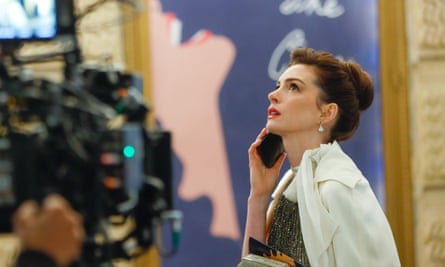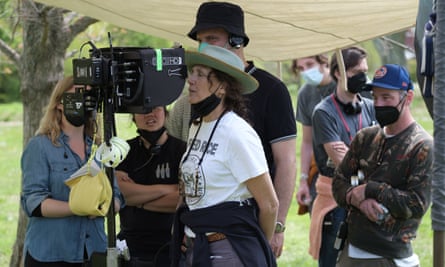[ad_1]
What do you do with a storyline requiring two US states with different marriage laws, reachable in a single journey without resort to roads? The obvious answer, for a writer as versatile as Rebecca Miller, would be to work it into a novel or short story. But no, it was a film she wanted to make. “I realised that I needed two states on a river where they had different laws. It was like a crazy puzzle that I was trying to figure out,” she says. Her solution was a tugboat which could chug between New York and Delaware. This led to a riot of further possibilities: what if one of the characters was an eccentric female tugboat captain suffering from erotomania, who fixates on a creatively blocked opera composer with a therapist wife who would really rather be a nun?
The result, She Came to Me, which premieres in Berlin on 16 February, is one of the wackiest romcoms ever to lay claim on the genre: an intergenerational story of love overcoming every obstacle that modern domestic life can throw in its path. “When I read it I thought it was a creatively risky, golden-hearted script full of incredibly drawn, nuanced characters – a somewhat rare find. I felt very clearly how much I wanted the film to exist,” says Anne Hathaway, who plays the cleanfreak therapist.
Though its characters are all one-offs, the film itself is firmly anchored in the social realities of the stepfamily – which is a set-up with personal resonance for Miller herself. Her marriage to the actor Daniel Day-Lewis made her stepmother to his son, Gabriel-Kane, from an earlier relationship with the French actress Isabelle Adjani. “Not only do I have a stepfamily, but I’m surrounded by others who have them,” she says, “so I can look at my own experience, and then other people’s, and synthesise all of that.”
Miller and Day-Lewis have two more sons, one of whom – the artist Ronan Day-Lewis – helped out with styling of the film. They have homes in the US and Ireland, and she’s speaking from her office in New York, where the wall behind her is crowded with period postcards. It’s for a future film, set in the 18th century, but don’t assume it’s coming any time soon. She is very visual and the postcards are about creating a palette, she says. She’s a believer in what the theatre director Peter Brook once described as “the formless hunch”. “It might be based on something that really happened,” explains Miller, “or it could be that some mother of a child I knew 20 years ago said something that never leaves you, and you build a whole character on that person. You get an instinct, and then the best thing is to leave it in the unconscious for a long time, so that you don’t pounce on it and ruin it.”

Sometimes the instincts are weird, she admits. When she was making her 2009 film The Private Lives of Pippa Lee, she was simultaneously reading a book about the Marquis de Sade, “and I was just mesmerised by that world of 18th-century Paris.” The result was Jacob’s Folly, a novel about an 18th-century French rake who is reincarnated as a housefly in modern-day New York.
She Came to Me did in fact grow out of a short story, published in her most recent collection, Total, which was a jeu d’esprit set in an Irish bar. One of the formless hunches that inspired it came from an outing with a friend 30 years ago to a Sex and Love Addicts Anonymous meeting. “I don’t remember why she decided to take me, but I was listening and it was just like, ‘I’m doing really well. I haven’t rented a little place for six months, I’m not watching any movies …’” It all fed directly into the character of tugboat captain Katrina (Marisa Tomei), who propositions the tortured composer Steven in a pub, after he has been sent out by his wife to take the dog for a walk and find himself a random adventure-cum-cure for his depression on the streets outside their home.
Steven is played by Peter Dinklage, who brings with him the celebrity of the roistering Tyrion Lannister, one of the few lovable characters in Game of Thrones. The camera in Miller’s film doesn’t shy away from his short stature, looking dizzily upwards at the obsequious faces of those congratulating him at one of his opera premieres, and making comic capital out of his relationship with a small French bulldog. When I suggest that She Came to Me would be a very different film without him, Miller says, “Yeah, that’s very true. I really felt that Peter made the film, because he never hits a false note as an actor. It’s almost like watching a cat: cats can never look fake. Plus, he carries with him a sense of history, and maybe even suffering, as a character.”

Although, as the daughter of the playwright Arthur Miller and the photographer Inge Morath, Miller herself had what appears to have been a privileged early life, listening in to the dinner-party banter of her parents’ starry friends from a perch beneath their dining-table, she has somehow emerged uncowed and unspoiled. “Rebecca is brilliant, kind, enchanting, creative, incredibly determined – I could go on and on,” says Hathaway. “She’s full of iron but has a butterfly touch. She’s endlessly compassionate. I adore her.”
Her career seems to have been on fast-forward ever since her first film, Angela, in 1995. Has she ever suffered from writer’s block? Yes she has, she says. “It was just after I got married. I think I was just happy. I don’t know what happened but I couldn’t write. I was in Dublin. And it was really terrifying, because my husband was working, and I was home with the kids.” She ended up volunteering in a local women’s shelter – “not thinking I’m going to get material, just thinking ‘I need to do something.’” Out of it came one of the stories in Personal Velocity, an award-winning collection of prose portraits of women which then became an award-winning film.
after newsletter promotion
She Came to Him’s characters cover a wide social and political spectrum. One of the advantages of living in New York, says Miller, is that “it’s such a layer cake of different people constantly crossing paths. It’s not like other kinds of cities where people drive a lot; New York is so compact that we see each other in the subway, on the bus or on the street all the time, and are always having encounters with unlikely people.”

Miller’s level-headedness keeps the film real, preventing it from veering into glib caricature – even when it’s portraying a bullying patriarchal stenographer who spends his free time dressing as a Confederate in civil war reconstructions, and could so easily have become a representative of the culture wars of today. Trey’s backstory is that he has adopted the daughter of his wife, a single mother of precarious immigration status. Though he explodes when he sees this daughter holding hands with a mixed-race boyfriend, an earlier scene shows him hosting one of her black friends. “Well she goes to public school in New York City, so of course she’s going to have friends of different races,” says Miller. “It’s not like he’s wandering around with Confederate flag tattoos, but there’s something that he can’t get past.” She consulted a dramaturg, “who said: ‘He’s one of those people who isn’t racist until he is.’ I thought that was a really cool way of putting it.”
Parents don’t have it easy in the film. “I mean, that’s something any parent would recognise, isn’t it?” says Miller. “That feeling of trying desperately to communicate with them when they don’t want anything to do with you because they’re going into a different place? It’s a struggle, and you just have to go quiet and realise that they’re speaking a different language. There’s an abyss between you and your kids, though hopefully you can maintain the bridge.” In her film, the tugboat sails blithely through the middle of it all.
[ad_2]
#Rebecca #Miller #abyss #kids #Theyre #speaking #language
( With inputs from : www.theguardian.com )

Leave a Reply